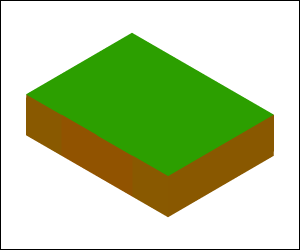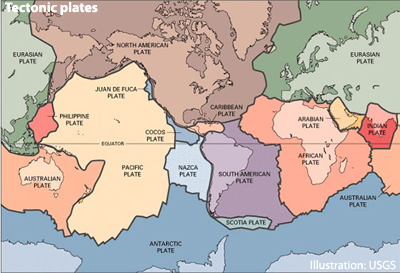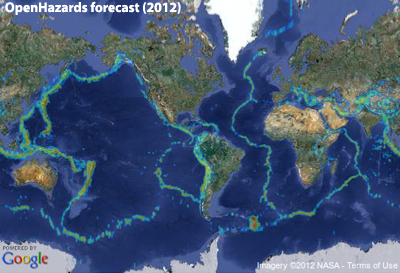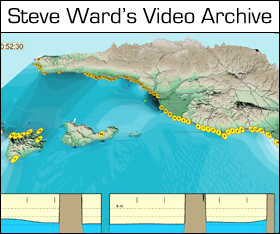Earthquakes

Animation of a "strike-slip" earthquake fault.
In an earthquake, the pressure released when a fault slips causes ground waves that radiate out from the source. These waves cause the ground shaking we experience as an earthquake. OpenHazards measures this building pressure by counting the number of small earthquakes in the vicinity and we use these numbers as part of the basis for our forecasts of larger earthquakes.


Earthquakes (forecast as brightly colored spots) can be expected to occur along tectonic plate boundaries.
Different faults have different amounts of earthquake potential and activity. Every fault has a slip rate, or the average speed at which one side of the fault moves past the other. Tectonic plates move very slowly, so slip rates are measured in millimeters per year (mm/yr). An average major, active fault will have a slip rate of 1-2 mm/yr. To calculate a slip rate, seismologists can use geological features to measure a fault’s movement over a long period of time. For example, where a 2500-year-old river crossed a fault, the two segments of riverbed would no longer meet and scientists could measure the distance the fault had moved them apart over 2500 years.
While tectonic plates move at a constant rate, most faults do not. When a fault does moves slowly without rupture, it is said to “creep.” Evidence of creep can sometimes be seen in slightly displaced buildings or a jog to the left or right in a sidewalk. Most faults do not slip much at all most of the time, and when they do slip, they cause earthquakes. A typical fault with a slip rate of 2 mm/yr might have one earthquake approximately every 100 years that creates about 0.2 meters of displacement in a matter of seconds.
Effects of earthquakes
In movies, earthquakes often create large crevasses and the dramatic potential to fall into the core of the Earth. Real earthquakes do not cause the ground to open up along a fault. In fact, the sides of a fault must push against one another to create the friction needed to build pressure and cause an earthquake in the first place. However, earthquakes can cause some dramatic secondary events. Sandy water-saturated soil may become liquid-like during ground shaking, like quicksand. This process, called liquefaction, can create new ground formations and tilt or sink structures or vehicles. Additionally, when an earthquake shifts a large body of water, the water displacement will trigger a large standing wave, or tsunami.
Poll
| 1. | Tokyo | 68 |
| 2. | Los Angeles | 25 |
| 3. | Manila | 18 |
| 4. | Bandung | 17 |
| 5. | Santiago | 16 |
| 6. | Nagoya | 9.4 |
| 7. | Osaka | 9.4 |
| 8. | Jakarta | 9 |
| 9. | Lima | 8 |
| 10. | Chengdu | 7.5 |




